- Surviving Vancouver
- Midtown Press (2024)
It’s hard to bet on what will survive in Vancouver.
Take the painting above by local artist and heritage advocate Michael Kluckner. Completed in the year 2000, he thought he was capturing the final days of the Sunrise Market in the West End.
Rising up behind it on Robson Street was the Empire Landmark Hotel. When it was completed in 1973, it was the tallest of its kind, a herald of the growth that the city would experience in the coming years. The hotel even boasted one of those revolving restaurants that every city, surely, needs to be world class.
But fast-forward to the present. That little shopfront that housed the Sunrise is still here, now the beloved Cardero Cafe.
As for the Empire Landmark? In 2018, its demolition began, once again breaking a record: it was the tallest building to be taken down in the city’s history. A new development with the same name is coming soon.
“It’s ironic. The Landmark really was a landmark,” said Kluckner of the painting that graces the cover of his newest book, Surviving Vancouver.
The pressures represented in the image have only continued to build up as the city has. It’s been almost four decades since the development — and demolition — boom around Expo 86 led to an interest in his works that capture the beauty and stillness of a Vancouver moment before it vanishes. Surviving Vancouver comes exactly 40 years after Kluckner published his book Vancouver the Way It Was.
“In ’88, I’d look for language in Real Estate Weekly that said that this building was to be bulldozed. ‘Attention, builders,’ it would say,” said Kluckner. “And I’d think, ‘Hmm, what’s this? That’s kind of interesting.’ So I began to explore the neighbourhoods and see things that looked like they were about to be torn down and I started painting them.... And that really took me from being a popular historian guy with a book like Vancouver the Way It Was to becoming a bit of a fire breather and activist on heritage preservation — this whole thing of: what is the character of the city? Is it only views? Or is it actually a place where we live?”
Many of the book’s works feature familiar glimpses of built history like the corner store and the hotel tower, from the first skyscrapers of a burgeoning city to the famous manors of the city’s elite to the picturesque neighbourhoods that sustained family lives before their humble houses took on multimillion-dollar price tags.
Vancouver has never looked so dreamy in watercolour, especially as Kluckner paints the seasons: spring clouds over the harbour, summer light in tree canopies, autumn leaves in sidewalk puddles, a winter walk through the snow to a grocer on Commercial Drive.
“You could almost call me a romantic landscape painter; I just love painting the weather,” he said.
But Kluckner is interested in much more than esthetics.
“On the other side, I’m still just a 25-year-old cartoonist.”
There are pictures in the book that look like they could be political cartoons but are real, like a window display at the Bay with the tag line “The Spring Forecast Calls for Style,” with a figure curled up in a sleeping bag in front of the well-dressed mannequins.
Readers are invited to ponder two questions with Kluckner’s scenes of the city, some of which no longer exist or have evolved. What’s survived in Vancouver? And how do you survive in Vancouver?
While the watercolours are a highlight, Surviving Vancouver is an engaging historical scrapbook that readers will get lost in as they explore these two questions.
“Neighbourhoods are changing with everything to do with zoning, land speculation and other tensors,” said Kluckner. Even in the quietest of his pictures, you can feel the pressures of change. In one painting of Shaughnessy, a mansion sits in wait, empty, boarded and graffitied.
“Old people like me who got into [the city] early, we’re just coasting along. What happens after? What’s surviving going to look like?”
In the introduction, a series of bird’s-eye-view maps show a landscape once home to Indigenous Peoples carved up by settlers, from mills to military reserves to railway lands, and shaped into today’s Metro Vancouver.
Contested space is a big theme of this place, says Kluckner, and his writing tells the stories behind the art, unpacking the politics and power players that have made and unmade pockets of the region, from the creation of Shaughnessy to the rise of the so-called Amazing Brentwood — the towers of which are done in ink, not deserving watercolours.
While there are a lot of buildings, Kluckner never forgets the people. Among the survivors are street vendors, people living in their RVs during the pandemic and binners, collecting and refunding recyclables to make ends meet. Many of them pop up across the pages so that readers don’t forget them either.
Sprinkled throughout are also newspaper clippings, with characters that will be surprising to the Vancouverites of today, like wartime squatters leaving the waterfront with violins in tow, and headlines of the past that are no different from those of today, like one from the 1980s telling of demovicted renters.
It’s a lot of weighty history, but Kluckner showcases the delights that make people love Vancouver so much, whether it’s the familiar sight of waves in the wake of a ferry or the vendors on Robson Street.
Here is a sampling of Kluckner’s city sights that tell stories of survival.
The Birks clock
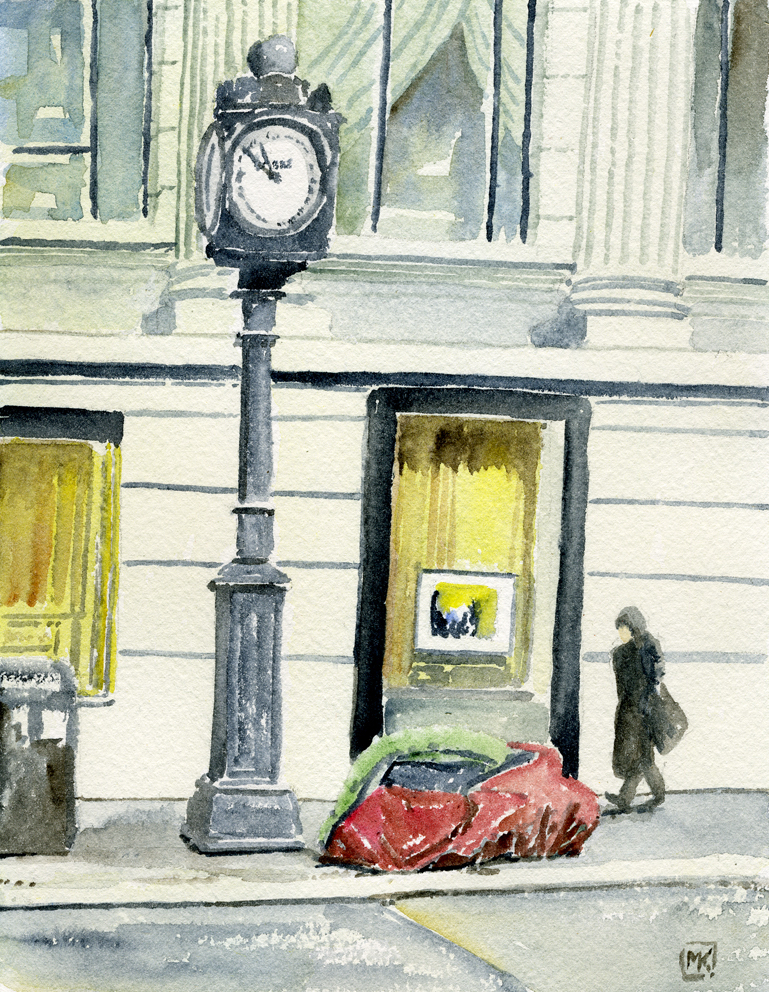
Owned by the jewelry retailer Birks, the memorable clock has moved a number of times since it was built in 1906. For decades, it was the recognizable downtown landmark near which meetings were arranged in the era before cellphones. Its current location is at Hastings and Granville, moved there in 2010 for the Winter Olympics.
“Birks and its clock are still there, elegant jewelry and art displayed in its window, but there is a tent pitched at the base of the clock,” writes Kluckner in the book. “From the tent comes moaning and shouting — a man crying out in a mental-health crisis. He can be heard from a block away, but there is no one to help. People walk by. It’s become normal.”
The Jeffs Residence
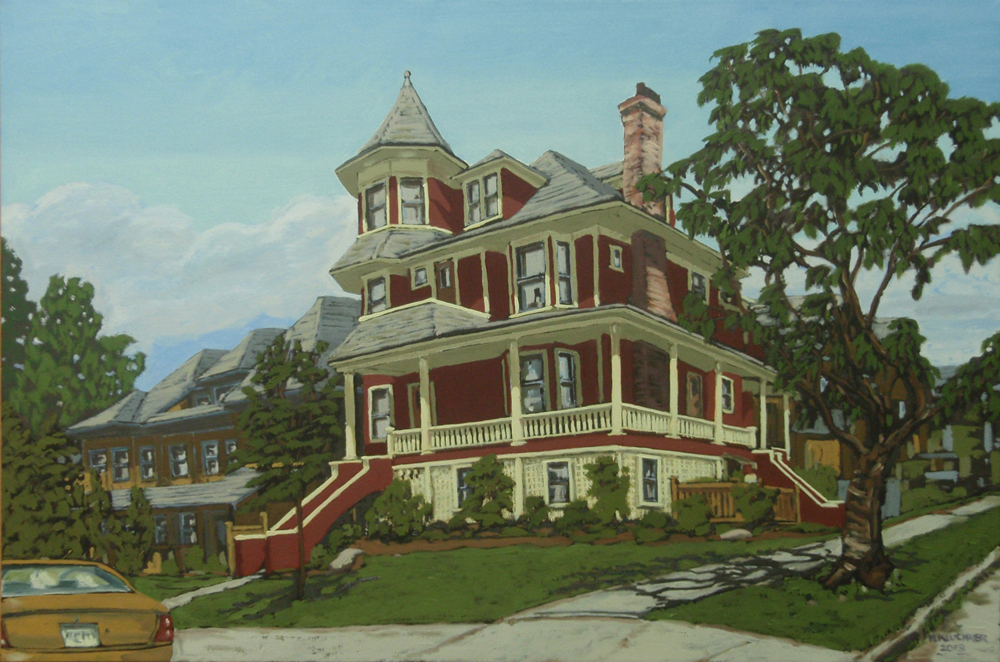
Completed in 1908, the sprawling 3 1/2-storey house on the corner of Salsbury Drive and Charles Street was the home of Dr. Thomas William Jeffs, the city’s coroner. The house still stands and it’s got more people on the property than ever before, a testament of how buildings evolve to fit the needs of the city today.
“James Evans, he’s the builder who’s done these projects: taken a big old house, converting it into units, and then he’s infilled them,” said Kluckner. “[Jeffs] is a huge success, a little community of townhouses with everything. In the neighbourhood, you can hear the people who have set up there. Babies being born. People sharing babysitters. All that sort of community. I think that’s so important.”
The Balmoral Hotel
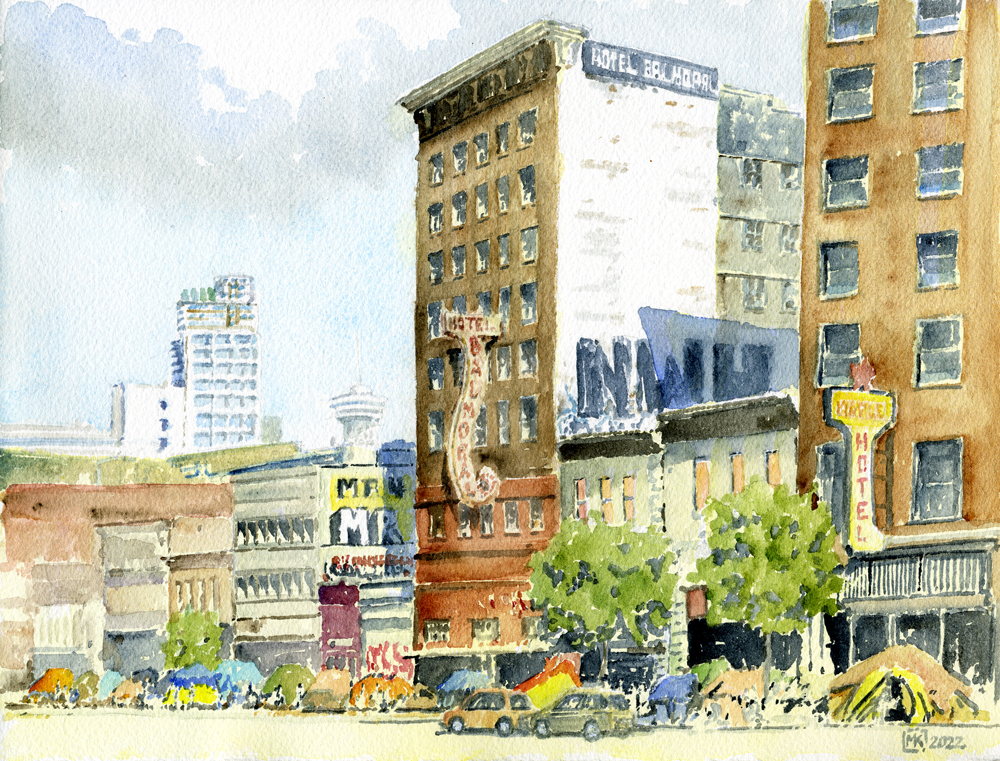
It was built in 1912, when Vancouver, at the end of the railway, staked its claim as the province’s hub of finance, manufacturing and shopping.
The Sahota family eventually bought the property, which functioned as a “single-room occupancy” of small rental homes, and allowed it to fall into disrepair. The city expropriated the decrepit building in 2020, with demolition underway in phases.
“I went by there on the bus the other day and it’s down to about that level,” said Kluckner, pointing to about halfway of the building’s height.
It was a landmark of the city’s prosperity, but would become a landmark of the struggles of the Downtown Eastside neighbourhood. Kluckner painted the icon for the book as it looked in recent memory, before its final days.
The city disposed of the neon sign as part of the demolition, claiming that it was “not possible to salvage or restore” it.
Pay phones, menus, newspapers
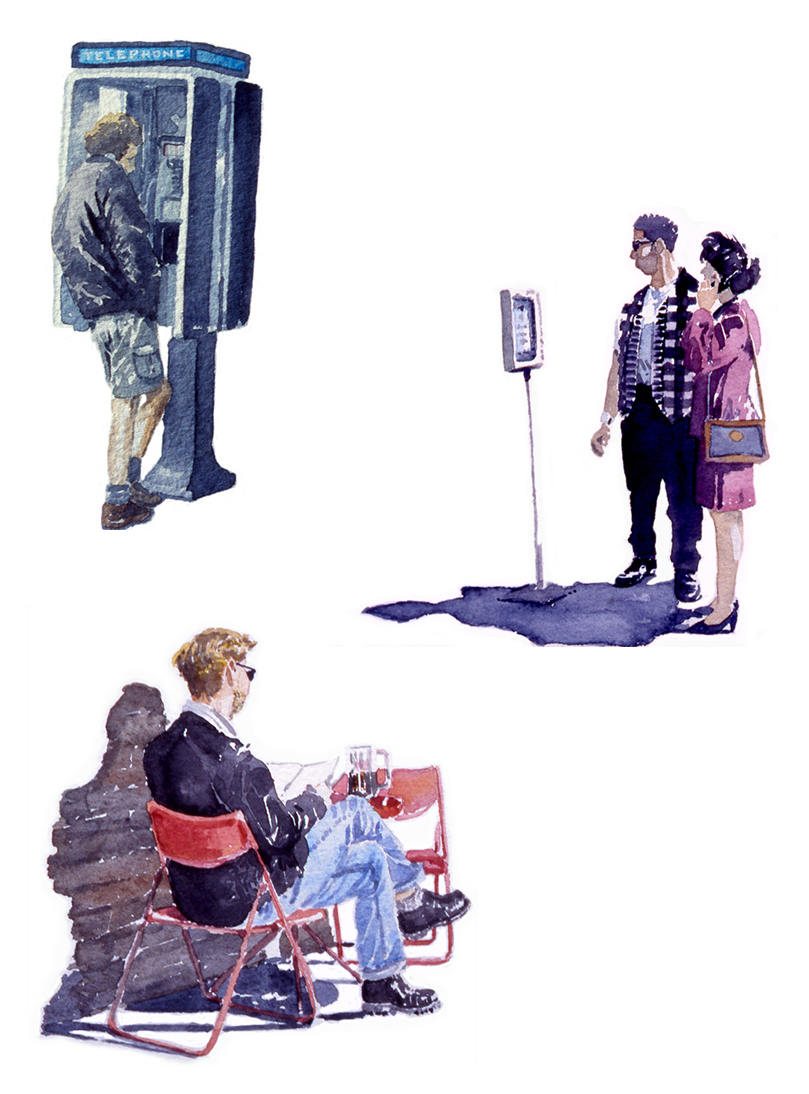
Kluckner has included some watercolour sketches of Vancouverites in the 1990s, making calls, deciding what to eat, reading the headlines of the day.
You’d be hard pressed to find a phone booth today and many newspaper bins have vanished. Physical menus are currently doing battle with QR codes.
Some of these sketches appeared in his 1996 book. The fashion and accessories tell you how much things have changed.
“There was only one vignette of a person on a cellphone,” recalled Kluckner.
Ancient trees
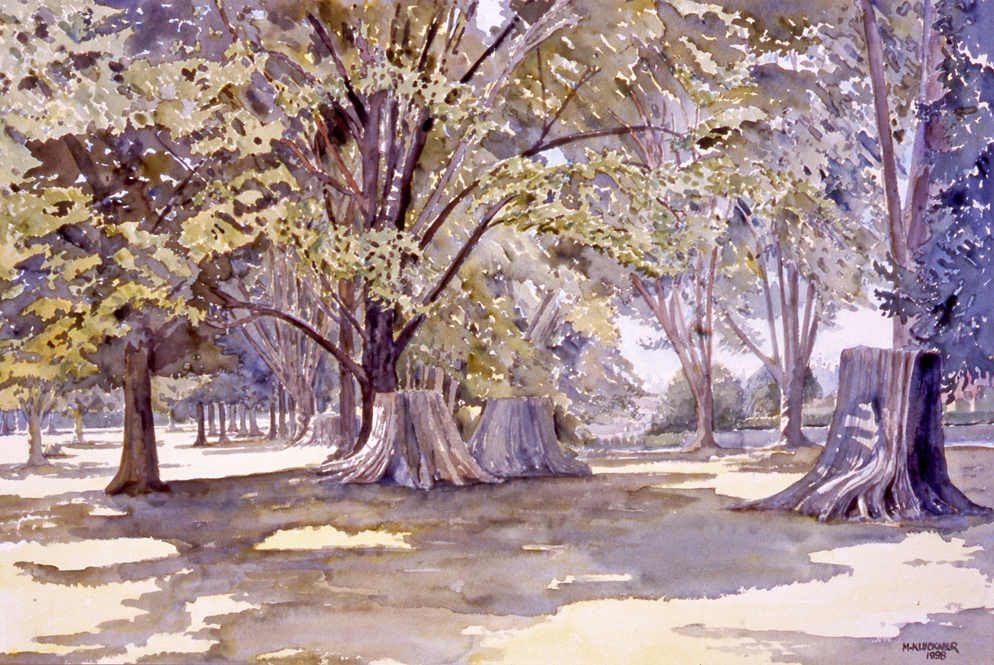
Apart from built history, Kluckner also captures Vancouver’s natural history before colonization.
With climate change and the lingering fear of heat domes like 2021’s, cool shade like that of the scene above means all the more in paved cities.
“The stumps of ancient trees were left in Maple Grove Park in Kerrisdale more than a century ago in a rare (for the time) acknowledgment,” he writes, “that there was anything here before.” ![]()
Read more: Books, Art, Urban Planning




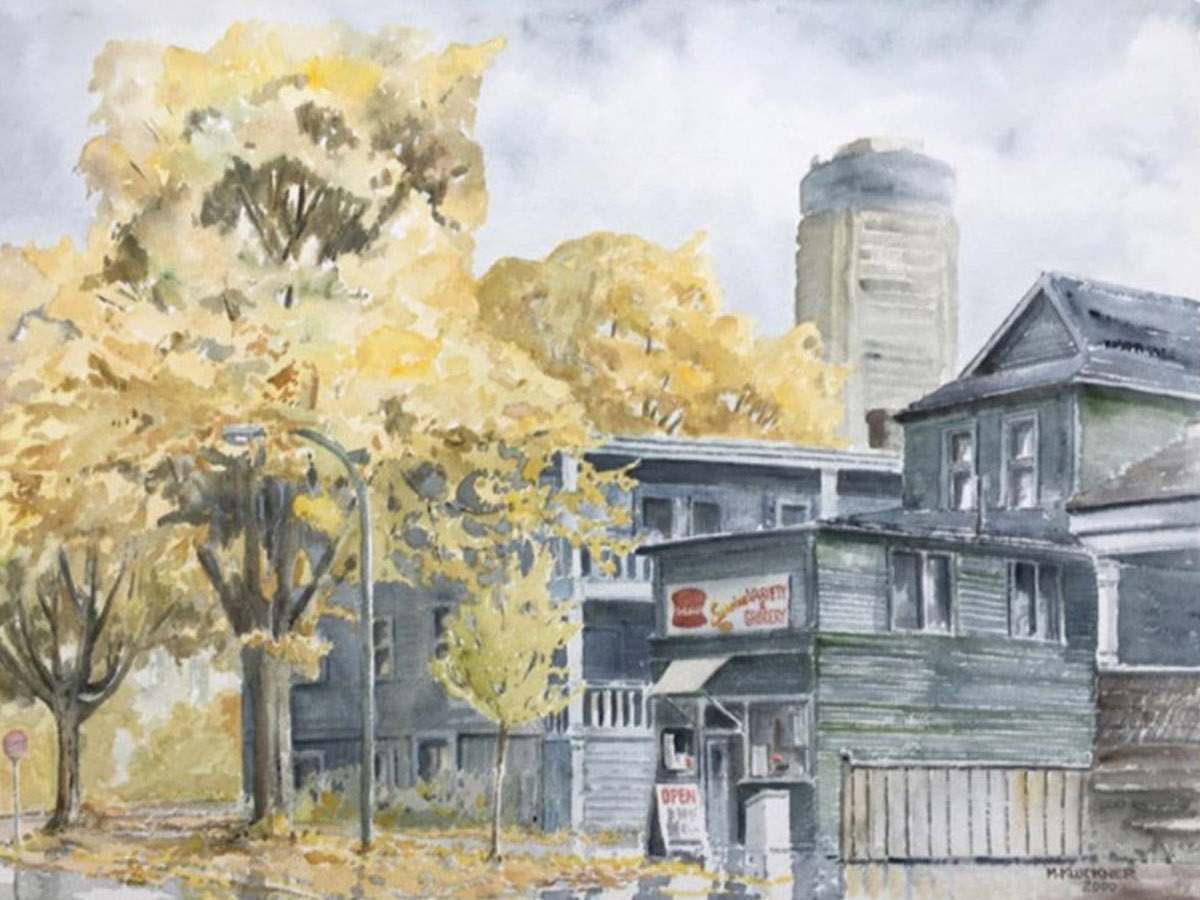


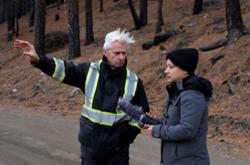









Tyee Commenting Guidelines
Comments that violate guidelines risk being deleted, and violations may result in a temporary or permanent user ban. Maintain the spirit of good conversation to stay in the discussion and be patient with moderators. Comments are reviewed regularly but not in real time.
Do:
Do not: